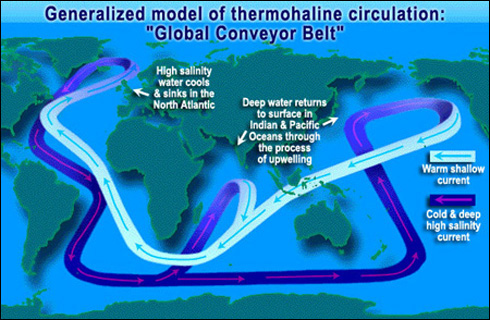Well, we’ve hit another major climate record. Yesterday the National Snow and Ice Data Center, out of Boulder, Colorado, issued a statement indicating that we’ve finally hit the low point for the volume of sea ice in the Arctic. Every year the amount of ice in the Arctic rises and falls with the seasons, as one would expect. September is typically when we see the end of the summer melt off, before the temperatures start to significantly drop and the ice starts to accumulate again. This year we’ve fallen way below the average low point for ice volume, breaking a record that has stood since they were able to put satellites above the north pole to study this phenomenon.
To provide some perspective, the continental United States contains 3,119,884 square miles. The size of the Arctic ranges quite a lot, but in its current late summer state, it has 1.32 million square miles, which is about 42% of the size of the US, or about twice the size of Alaska. It is about 18% below the previous 2007 record, and 49% below the 1979-2012 average. From the graph below, one can see that it has generally on a downhill slide since they started taking measurements in 1972.
Some scientists are estimating that within the next 20 years, Arctic sea ice will completely disappear during the late summer months. If this happens, and it is likely that it will, it will cause all kinds of serious problems with the environment. The white sea ice has a very high index of reflectivity, but the dark color of the melted ocean water will absorb the warmth of the sun, further complicating the trend toward global warming. The worry is that, if the sea ice is lost, then the added warmth of the atmosphere will lead to the accelerated loss of the freshwater ice locked up on Greenland (which is melting fast anyway). Unlike the Arctic sea ice, which is frozen sea water, Greenland is freshwater because it is ice that sits on land and has accumulated through moisture that has come from the atmosphere. Greenland holds so much frozen freshwater that when it melts into the sea, it will actually cause the oceans to rise, which is what most media outlet talk about. However, there is another more serious outcome. It will likely stop the naturally occurring currents of water that move around the planet.
The salinity of ocean water changes depending on where you are in the world. It also changes depending on how deep you are in the ocean. The currents move according to the salinity levels, and this giant conveyor belt moves warm waters northward, and cold waters to the south, creating a perfect balance which our 21st century cities are built for. It is called Thermohaline Circulation. If Greenland melts off, and dumps all that freshwater into the high salinity north Atlantic, it will likely shut down the conveyor belt, therefore slowing, or stopping, the warm waters of the south from moving northward. The result of such an event is nothing short of the next ice age because water is a fantastic heat sink, and the constant movement of the ocean water keeps a consistent temperature balance on the planet. I realize that calling for the next Ice Age sounds inflammatory, but it is a real possibility, that is not really discussed in the media.
You may have heard that Greenland has, like the Arctic, had record melting this year. It has been all over the internet. PBS did a pretty nice job putting it in context. Also, this (admittedly overly dramatic) video gives you a feel for the amount of water that is melting in just one location. They say that this particular 4 day melt is a result of a localized weather event, as opposed to climate change. It sure seems like it is part of a larger trend. I guess we’ll have to stay tuned to see if it continues to happen, or if this is just a single event.
So, I write about these things, knowing that there are many unknowns in the scientific community regarding these events. Similarly, I fully admit that like most people, I am not a researcher, and do not have the expertise to know anything for certain. However, this is one of the many things that I see in the world that tells me that we are heading in the wrong direction and things must dramatically change soon. It wakes me up from the numbness I’ve experiencing living in the bubble. You see, the feedback loops of major global systems are getting disrupted as a result of fossil fuels. The scientific community is in total agreement that our use of fossil fuels, in all their varied uses, is causing climate change. Climate change is causing the Arctic to melt, which has systemic relationships with a whole host of other complex systems (including the melting of permafrost).
The question of whether coal-fired energy plants, or oil based combustion engines, are appropriate as we move into the near future seems to totally miss the point. Both are totally inappropriate when more appropriate technologies already exist today. It amazes me that oil companies are spending billions of dollars to get to the sub-surface oil that is below the arctic. It is so incredibly inappropriate. Put your billions of dollars into something healthy, that makes sense to the long term welfare of the human race. The change will come eventually. It has to. It’ll be hard, but it’ll be much easier if we do it boldly now, rather than desperately later.



